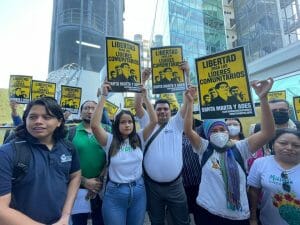NOVANEWS
-
As a form of reparation, Cardenas wants museums to be built explaining the truth.

-
Cardenas Basantes regained his identity through the Reparation for Victims program.

-
Ministries and the Truth Comission are working to provide material and non-material reparation for victims.

-
Ecuador’s truth commission is overseeing reparation for victims
During the ongoing work of Ecuador’s Truth Commission, teleSUR talks to victims who have received reparations.
Over 450 victims of human rights abuses and crimes against humanity have been identified in Ecuador as part of a truth commission, and victims are receiving compensation as part of an ongoing project for justice.
Over two-thirds of the 456 abuses, carried out over a thirty year period, occurred under the government of Leon Febres Cordero, from 1984 to 1988.
Kidnapped, imprisoned and tortured on various occasions, Mireya Cardenas, a former member of the revolutionary guerilla group Alfaro Vive ¡Carajo!, is one of these victims. Cardenas was captured by the CIA in August 1985 while changing planes in Costa Rica, en route to attend a conference in Nicaragua.
Under the Law for Victims put forward by the Truth Commission in 2013, victims like Cardenas, and their families, are receiving material and non-material reparation for the crimes committed against them.
Cardenas told teleSUR English, “I was there eight days, without any form of communication, kidnapped, tortured; they used animals, such as dogs and rats, for the psychological and physical torture. After being there for eight days without food, they brought me here to Ecuador, breaking all norms for extradition. They brought me to Ecuador and they turned me into military intelligence.”
“Military intelligence held me for eight more days in what was called “Little Hell,” which was a site, a laboratory, built to torture under the CIA manual. And I do think it was under the CIA manual because in Costa Rica the same torture methods were used as here. In this laboratory … they gave me electric shocks, made me strip naked, used cold water, they put a hood over my head, witheld food, and also continualy humiliated me and violated me psychologically. And after I left, they took me to prison again,” said Cardenas.
As a form of reparation, Cardenas and other victims from Alfaro Vive ¡Carajo! are working to transform those spaces used for torture and repression into truth museums.
On reparation, Cardenas said,“We have fought for these symbolic reparations. So that the truth is known about what happened here in the country. So that the honorable names of our comrades are recognized. So that we have sites for memory. A museum of truth is an option which we have been talking about for a few years now, which is going to be built at the SIC of Pichincha, a site where many people were tortured.”
Cardenas and her partner Fausto Basantes, the second in command of Alfaro Vive ¡Carajo!, gave birth to a son who was put under the care of his uncles and forced to change his last name for protection. Through the Reparation for Victims Program, sponsored by various ministries and the Truth Commission, after 29 years their son, Fausto Eloy Basantes Cardenas, had his true identity recognized by the state March 4.
Basantes Cardenas said,“It was a process to regain my identity, but now having this identity makes me extremely proud. Having this new identity card, which we have to carry everywhere, reinforces that Mireya Cardenas and Fausto Basantes are my parents, they are my biological parents, and this fills me with pride. And this is because I really admire my parents.”
He went on to say, “I love being their son, and I believe that my father giving his life and my mother, willing to give her life, [were] fighting for this country. For their convictions, for their ideals, for a better Ecuador, this is something that should make everyone proud.”
Taking the stories and experiences of the Alfaro Vive ¡Carajo!, and other affected individuals and groups, the Reparation for Victims Program is working to continue providing justice and material as well as non-material reparation for those victims of crimes committed by the state.
Over two-thirds of the 456 abuses, carried out over a thirty year period, occurred under the government of Leon Febres Cordero, from 1984 to 1988.
Kidnapped, imprisoned and tortured on various occasions, Mireya Cardenas, a former member of the revolutionary guerilla group Alfaro Vive ¡Carajo!, is one of these victims. Cardenas was captured by the CIA in August 1985 while changing planes in Costa Rica, en route to attend a conference in Nicaragua.
Under the Law for Victims put forward by the Truth Commission in 2013, victims like Cardenas, and their families, are receiving material and non-material reparation for the crimes committed against them.
Cardenas told teleSUR English, “I was there eight days, without any form of communication, kidnapped, tortured; they used animals, such as dogs and rats, for the psychological and physical torture. After being there for eight days without food, they brought me here to Ecuador, breaking all norms for extradition. They brought me to Ecuador and they turned me into military intelligence.”
“Military intelligence held me for eight more days in what was called “Little Hell,” which was a site, a laboratory, built to torture under the CIA manual. And I do think it was under the CIA manual because in Costa Rica the same torture methods were used as here. In this laboratory … they gave me electric shocks, made me strip naked, used cold water, they put a hood over my head, witheld food, and also continualy humiliated me and violated me psychologically. And after I left, they took me to prison again,” said Cardenas.
As a form of reparation, Cardenas and other victims from Alfaro Vive ¡Carajo! are working to transform those spaces used for torture and repression into truth museums.
On reparation, Cardenas said,“We have fought for these symbolic reparations. So that the truth is known about what happened here in the country. So that the honorable names of our comrades are recognized. So that we have sites for memory. A museum of truth is an option which we have been talking about for a few years now, which is going to be built at the SIC of Pichincha, a site where many people were tortured.”
Cardenas and her partner Fausto Basantes, the second in command of Alfaro Vive ¡Carajo!, gave birth to a son who was put under the care of his uncles and forced to change his last name for protection. Through the Reparation for Victims Program, sponsored by various ministries and the Truth Commission, after 29 years their son, Fausto Eloy Basantes Cardenas, had his true identity recognized by the state March 4.
Basantes Cardenas said,“It was a process to regain my identity, but now having this identity makes me extremely proud. Having this new identity card, which we have to carry everywhere, reinforces that Mireya Cardenas and Fausto Basantes are my parents, they are my biological parents, and this fills me with pride. And this is because I really admire my parents.”
He went on to say, “I love being their son, and I believe that my father giving his life and my mother, willing to give her life, [were] fighting for this country. For their convictions, for their ideals, for a better Ecuador, this is something that should make everyone proud.”
Taking the stories and experiences of the Alfaro Vive ¡Carajo!, and other affected individuals and groups, the Reparation for Victims Program is working to continue providing justice and material as well as non-material reparation for those victims of crimes committed by the state.




